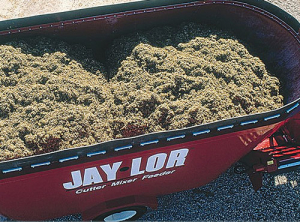Mixer makes feeding easy
Coolbreene Trust near Taupo is a large-scale dairy operation farming 1150ha, including run-off blocks, within a 10km radius of its home base.
 Canadian TMR specialists Jaylor say the purpose of its TMR mixer is to create a homogenous mix that resists sorting by the animals being fed.
Canadian TMR specialists Jaylor say the purpose of its TMR mixer is to create a homogenous mix that resists sorting by the animals being fed.
Manufacturers of total mixed ration (TMR) mixers should stop claiming their machines have “better steel, bigger tyres and brighter lights” than competitors’ machines.
So says Marti Phillipi, export sales manager for the Canadian TMR specialists Jaylor.
Phillipi accuses competitors of claims that have no bearing on the purpose of a TMR mixer – to create of different ingredients a uniform, homogenous mix that resists sorting by the animals being fed.
Jaylor (the name originates from the names of owners Jake and Lorraine Tamminga) is located at Orton, 60km from Toronto, Canada.
The family business started in 1993, aiming to make a mixer to deal with the large round bales of hay and silage that had become increasingly popular during the late 1980s.
“Total mixed rations (TMR) are the single most-influential factor in increasing milk production in North America in the last 20 years,” says Jaylor president Jake Tamminga.
He developed a vertical auger concept that remains to this day; its development during the ensuing years led to 36 patents -- six of them applying to the auger design.
The patented Square-Cut auger cuts and carries material upwards in the tub, then releases it to tumble downwards to achieve mixing. The sloped top of the auger prevents bridging of round bales, allowing them to be cut rapidly and achieve a good mix in a shorter time frame.
A novel side plate gathers material, moving it to the centre of the auger for lifting and reducing friction between the auger and the tub wall, cutting power need by 20% and helping extend the life of the tub.
This contrasts with manufacturers statements about ‘re-lining’ options for their machines. Simple Perspex viewing windows in the tub allow the operator to watch the mix in progress and decide when it is ready.
Cutting is achieved by a combination of carbide-coated horizontal and vertical knives that are self-sharpening and durable for long working life.
Machines range in size from Mini-Mixers (1.5cu.m) for feeding individuals or small groups, to single auger models (10-16cu.m), twin-augur units (18-29cu.m) and a model for large feed lots or ‘oversized’ operations.
Depending on the size, suspension can have single or tandem axles and single or twin tyre assemblies.
Discharge options include front, rear or side door combinations and the choice of a drop floor or different discharge conveyors for various feeding situations.
Other options are weighing systems, two speed drive trains for smaller tractors, brakes and central greasing.
A five-year warranty applies to certain components.
The National Wild Goat Hunting Competition has removed 33,418 wild goats over the past three years.
New Zealand needs a new healthcare model to address rising rates of obesity in rural communities, with the current system leaving many patients unable to access effective treatment or long-term support, warn GPs.
Southland farmers are being urged to put safety first, following a spike in tip offs about risky handling of wind-damaged trees
Third-generation Ashburton dairy farmers TJ and Mark Stewart are no strangers to adapting and evolving.
When American retail giant Cosco came to audit Open Country Dairy’s new butter plant at the Waharoa site and give the green light to supply their American stores, they allowed themselves a week for the exercise.
Fonterra chair Peter McBride says the divestment of Mainland Group is their last significant asset sale and signals the end of structural changes.